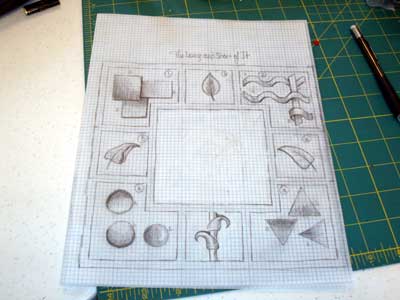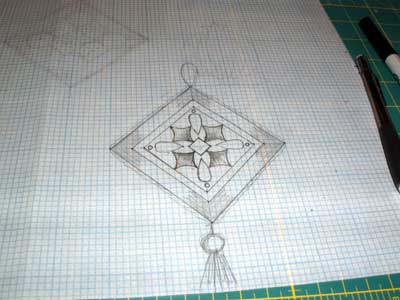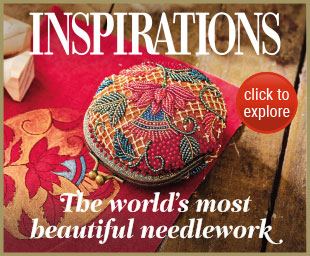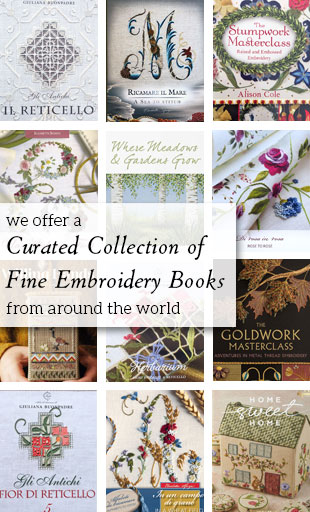I have two needlework projects in various stages of planning right now. One is a Christmas ornament and the other is the Long and Short Stitch sampler. Let me show you what I’m doing, discuss a bit about designing, and then tell you where I’m going next.
If you’re like me, designing your own needlework project is a bittersweet sort of adventure. The sweet side is the satisfaction – it’s nice to design and execute your own work, from scratch to finish.
The bitter side is that it can be somewhat intimidating. First, there’s the question of “What”? I often suffer from writer’s block at the designing table. That’s why I think it’s a good idea to doodle, and even to keep track of your doodling in a sketchbook or journal. Before doodling, you might want to get the juices flowing. You can flip open books and take some inspiration from what you see, or you can go outside and see what’s weird and wonderful in Nature. Somehow, you want the juices to flow, but at some point, you have to get it down on paper.
If you were taking a writing course, you’d be told to “brainstorm” or “list” – just plain start writing down anything that comes to mind, in order to get ideas out. For designing a project, the equivalent is doodling. Start doodling.
Once you have an idea, there are other intimidating factors to designing your own piece of needlework. There’s the question of “acceptability.” Sure, I like it – but will anyone else? Then there are the “professional” questions to take into consideration, too: form, order, line, color, texture – all that kind of stuff. For some people, that comes second nature. For people who are artistic, those questions may not pose a problem. For me, they do pose a problem, so I generally end up ignoring them, at least at first. My work probably suffers for that…!
If you’re interested in designing your own embroidery piece, you might want to check out a helpful article titled “Taking the Fear out of Designing” by Sue Stause. I think it’s a helpful, interesting, and informative article, though I probably don’t do everything she suggests. (My work probably suffers for that, too…!)
I’m not a professional designer – as I’ve mentioned before, I’m a hobbyist, not really an “artist.” I’m not formally trained for designing, drawing, color selection, and so forth. So, being the average Jane Doe when it comes to this type of thing, I just sort of work out things that I think will work out. And then I tweak and polish, just like a writer does with a rough draft.
After various doodles, this is what I’ve come up with for a long and short stitch sampler.

I suppose it looks a little more complicated than it is supposed to be. That’s another fault of mine, when it comes to designing. I tend to go overboard instead of adhering to the KISS – Keep it Simple, Stupid – rule.
The concept was to arrange, in seven stages, different levels and approaches to long and short stitch shading, progressing from geometric shapes to natural elements, following in order of level of difficulty. The whole thing is 8″ x 8″, and each element is generally within the 1 – 1.5 inch range, so small enough to stitch in (hopefully) one sitting.
The next project I’m working on is a Christmas ornament. I oscillated between using someone else’s design and making up my own, but the latter finally won out. This was a project that drew a blank for me for a long while. I knew the look I wanted, but couldn’t figure out how I wanted it to come across. Many doodles later, I think I’ve settled on an idea, but I think there will be a lot more tweaking to come.

The ornament will be a combination of goldwork and silk shading. There’s still a bit of tweaking to do there.
The next step on the Long and Short stitch sampler is to work on color ideas. This particular project is not really a “wing it” sort of project since I want to use it for instruction. It’ll take a lot more time at the design table.
For the Christmas ornament, though, with the basic shape in place, I’m actually ready to set it up for stitching. I know that sounds rather silly, considering I haven’t exactly figured out what I’m going to do where, but… that’s ok. I have enough of an idea that I can wing on this small project.
Do you like to design your own embroidery projects? Or would you prefer for someone else to do the designing for you? If you do like coming up with your own designs, how do you go about doing it? What’s your favorite designing medium?
Any suggestions and tips are always welcome – not just for me, but for others out there who may have that deep down desire to design, but who are too intimidated to go for it! Maybe you know something that will help the rest of us!!







I would love to be able to design my own embroidery, but I am one of those who wouldn’t know how to get what is in my brain onto paper, let alone stitch. I love seeing how people go from the idea and following through to the stitching. I’m hoping one day that the inspiration will be strong enough to overcome the fear
Lo siento mi ingles es terrible asi qye te repondere en español…
ante todo, Diseñar, q1ue es, es la combinacion de artistico y tecnico, por ello, lo primero es dominar la tecnica, conocimientos basicos forma color, textura, composicions. espacio, fin para ser utilizaco, materiales, acabadodo, en fin cosas que se pueden aprender, pero el componente mas importante es la parte artistica, esto a veces es algo de la persona, puedes llegar a obtenerlo, pero algunas personas les falta el toque de genialidad.
cunado quiero diseñar, busco una fuente de inspiracion yo tengo un cuaderno de diseño, en el tomo las notas o elementos que seran mis determinantes del diseño, y luego voy a la forma geometrica bi y tridimencional, la funcion, donde va estar, para quein, costo materiales, como acabarrlo todo esto es algo que empieza a engranar poco a poco y leugo a empezar, puede suceder que una vez terminado el trabajo se hagan ajustes y es valido.
Si me permites decir de tu diseño. veo 3 figuras geometricas simples en cada esquina, la cuarta no coresponde,,, asi que veo algo pasa.. en vez de ondas podria ser pentadonos, pues tienes una linaea que da un circulo, tres lineas con triangulo, cuatro figura paralelepidedoas, y ondas? no see… me encantaria que el cuadro superior fuera la continuacion del inferor, ahora que tiene que ver las flores con las figuras geometricas….-
saludos nela
Mary, Your design pad looks beautiful – mine is always so scratchy. I can’t draw but I scribble and draw shapes that make sense to me. I love to do my own designing even though occasionally I start from someone else’s basic idea – the satisfaction derived from coming up with an idea and executing it is just so wonderful – it has become my preferred option.
I rarely manage to get a complete design on paper or in my head before I start – I will begin a the basic outline and play with it as I progress. Sometimes I scan the work I have already stitched a couple of times and then make cutouts of sections I might want to repeat and push them around on an uncut scan until I get a pleasing (well, to me) composition.
Interestingly I find loose, abstract ideas easier to work with than say the design on a biscornu – Your ornament design is interesting.